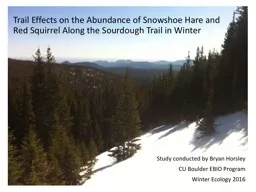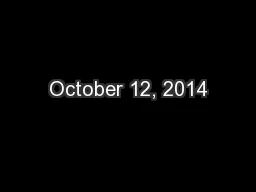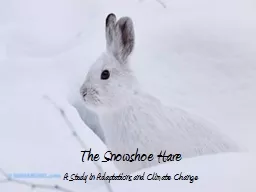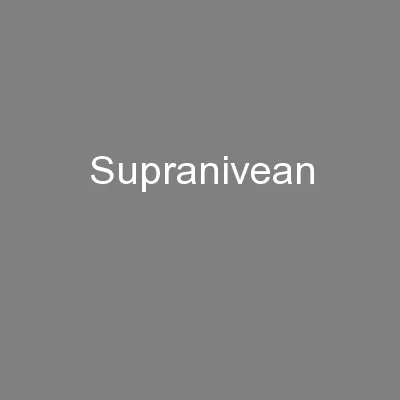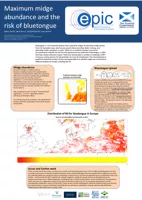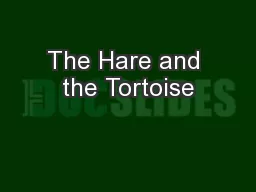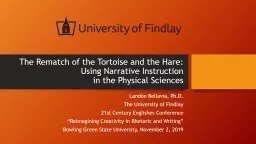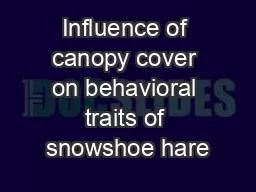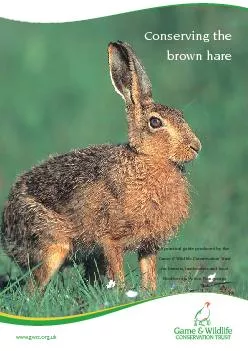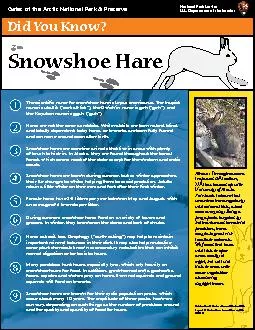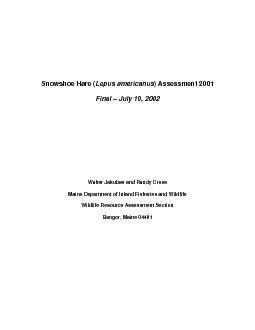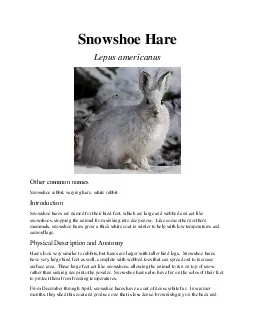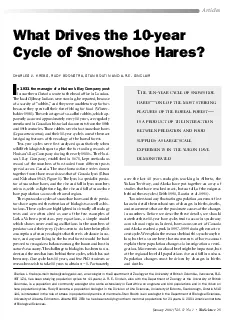PPT-Trail Effects on the Abundance of Snowshoe Hare and Red
Author : luanne-stotts | Published Date : 2018-09-30
Squirrel Along the Sourdough Trail in Winter S tudy conducted by Bryan Horsley CU Boulder EBIO Program Winter Ecology 2016 Research Question Is there a negative
Presentation Embed Code
Download Presentation
Download Presentation The PPT/PDF document "Trail Effects on the Abundance of Snowsh..." is the property of its rightful owner. Permission is granted to download and print the materials on this website for personal, non-commercial use only, and to display it on your personal computer provided you do not modify the materials and that you retain all copyright notices contained in the materials. By downloading content from our website, you accept the terms of this agreement.
Trail Effects on the Abundance of Snowshoe Hare and Red: Transcript
Squirrel Along the Sourdough Trail in Winter S tudy conducted by Bryan Horsley CU Boulder EBIO Program Winter Ecology 2016 Research Question Is there a negative trail effect on the abundance of snowshoe hares andor red squirrels along the Sourdough trail in winter. Training Guide. 30 Meter. 50 Meter. 75 Meter. 100 Meter. 200 Meter. 400 Meter. 2. Special Olympics Michigan. Events Offered. Suggestions. It is suggested that beginner athletes enter the 30-meter and 50-meter events. Intermediate athletes should enter the 75-meter and 100-meter races. Advanced athletes should enter the 200-meter, or 400-meter events. . Hare School. What do hashers want from a hash trail?. Question. Keep the pack together on trail. Give the hashers a fun, safe, social time. Allow hashers who want it the opportunity to run. Objectives of a good trail. A Study in Adaptations and Climate Change. Snowshoe. Hares. Camouflage. Adaptations. . What do you know about:. The main habitat of the snowshoe hare is a taiga biome. . The taiga has warm, humid summers and freezing cold winters. . travel of snowshoe hares on . Niwot. Ridge. Marieta Bialek. EBIO 4100. Winter Ecology . Spring 2012. Layout of Presentation . Introduction. Background. Snowshoe Hare, Relevance to Winter Ecology, . Bluetongue is . a viral livestock disease that is spread . by . midges (in particular midge species from the . C. ulicoides. taxa), . which causes severe illness and often death in . sheep, and somewhat milder symptoms . “I . am . the fastest . animal in the world. .”. said . a proud H. are.. But the . Tortoise . spoke . slowly. ,. “I . can beat you, should we race. ?”. Then. , the . race began.. At the . beginning. Using . Narrative Instruction . in . the Physical Sciences. Landon Bellavia, Ph.D.. The University of Findlay. 21st Century Englishes . Conference . “. Reimagining Creativity in Rhetoric and Writing” . Breanna Avery . Winter Ecology/ Spring 2018. Mountain Research Station, University of Colorado, Boulder. Professor Tim Kittel . Introduction. The snowshoe hare. (Lepus . americanus. ). Mostly found in coniferous and boreal forests of the rocky mountains . Game & Wildlife Conservation Trust www.gwct.org.uk An animal of the open country The brown hare The scienti c name for snowshoe hare is Lepus americanus. The Inupiak Hares are not the same as rabbits. While rabbits are born naked, blind, and totally dependent, baby hares, or leverets, are bo TABLE OF CONTENTS Page INTRODUCTION...................................................................................................4 STORY........................................ Why is chanting the holy name the Yuga dharma for Kali Yuga There are different processes to achieve perfection in each age In the Srimad kte yad dhyyato viu / trety yajato makhai In Satya Yuga the pr SourcesElbroch M 2003 MechanicsburgPA Stackpole BooksHoyt L 2016Mammals Dyken Pond Environmental Education Center Cropseyville NYOhio Department of Natural Resources ODNR ndMammals of Ohio Field guide ArticlesCharles J Krebs e-mail krebszoologyubccaan ecologist in the Department of Zoology at the University of British ColumbiaVancouverBCV6T 1Z4has been studying population cycles for 41 years A R E
Download Document
Here is the link to download the presentation.
"Trail Effects on the Abundance of Snowshoe Hare and Red"The content belongs to its owner. You may download and print it for personal use, without modification, and keep all copyright notices. By downloading, you agree to these terms.
Related Documents

